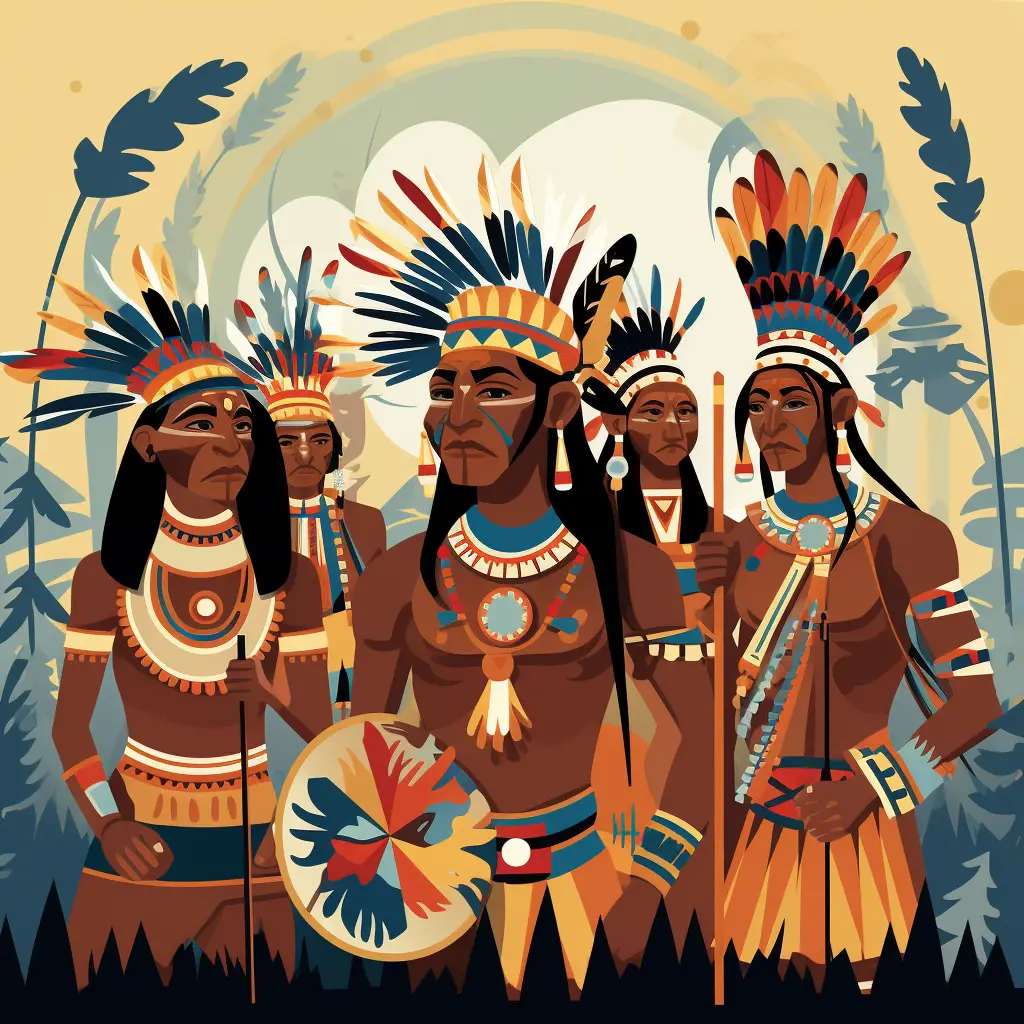The Seminoles
The Seminole Tribe is a Native American tribe that originated in Florida. They have a rich history and culture, with their own language, traditions, and customs. The tribe has faced many challenges throughout history, including conflicts with European settlers and forced removal from their ancestral lands.
However, they have persevered and continue to thrive today, with a strong sense of community and a commitment to preserving their heritage.
For centuries, native people known as the Muscogee lived in what would become the southeastern United States. They were incorrectly referred to as “Creeks” by English speakers. After the Creek War in 1813-14, which forced them to give up millions of acres of their land, the most determined Creeks fled to Spanish Florida.
There, they joined with the descendants of Indians who had lived throughout Florida’s forests for centuries. These native people referred to themselves as yat’siminoli, which means “free people.” Eventually, the Indians in Florida came to be known as “Seminoles.”

Seminole Tribe Facts for Kids
- The Seminole tribe originated from Native Americans in Florida.
- They’re known for their “chickee” stilt houses.
- They’re famous for their colorful patchwork clothing.
- “Seminole” means “runaway” or “wild people”.
- They traditionally hunted, fished, and farmed.
- They fought three wars against the US.
- Seminoles have their own tribal government.
- Their language is Muskogee and Mikasuki.
- They host the annual Green Corn Festival.
Seminole Tribe History
It’s impossible not to feel a deep sense of awe when you delve into the storied past of the Seminole Tribe, a resilient group that’s weathered countless storms throughout history.
Originating from the Creek people, the Seminole Indians emerged as a distinct group in Florida in the 18th century.
The Seminole Nation, despite facing forced removal from their lands during the infamous Trail of Tears, managed to resist and eventually thrive in their homeland.
The Florida Seminoles, known for their unmatched skill in alligator wrestling, are a testament to the tribe’s courage and adaptability.
Today, the Seminole Tribe continues to honor its rich history through cultural preservation and economic development, proving that they’re not just survivors, but also a tribe of innovators.
Native American Tribes in Florida
In your exploration of Native American groups in the Sunshine State, you’ll discover that one prominent community, not to be named here, has a rich history marked by resilience, adaptation, and cultural preservation.
This group, known for its vibrant patchwork clothing and alligator wrestling traditions, stands as a testament to the enduring spirit and ingenuity of indigenous peoples in Florida.
The Seminole Tribe of Florida is one of the most widely recognized Native American tribes. Historically, the Seminole people were farmers and hunters.
The tribe is known for its patchwork clothing, which is an integral part of their cultural identity. The Seminoles are famous for their alligator wrestling traditions, a skill passed down through generations.
Despite forced relocations and societal pressures, the Seminole tribe remains a strong and vibrant part of Florida’s indigenous people.
Seminole Wars
You wouldn’t believe the resilience shown during the Seminole Wars, a series of conflicts in the 19th century that saw this indigenous community fiercely defending their homeland against U.S military forces.
These Seminole tribe facts reveal a group undeterred by the pressure of American settlers eager to seize their lands. Despite the odds, the Seminole leader rallied his people, bravely leading them into battle time and time again.
The Seminole Wars, far from quelling them, only served to strengthen their resolve. Despite numerous attempts to broker a peace treaty, the Seminole stood their ground, refusing to be displaced from their native Florida.
Their tenacity during these wars is a testament to their unyielding spirit and a significant part of their rich cultural heritage.
Seminole Culture and Traditions
Despite the turmoil they’ve faced, these resilient people have managed to preserve a rich tapestry of customs and traditions that continue to thrive today.
The Seminole tribe, native to Florida, has a culture bursting with vibrancy and tradition. An indelible part of Seminole culture and traditions is their clothing. Known for their colorful patchwork designs, Seminole clothing tells a story and represents the tribe’s history and identity.
Their tribal traditions also encompass unique rituals, ceremonies, and social structures, deeply rooted in respect for nature and their ancestors.
As you delve into Seminole tribe facts, you’ll discover a fascinating culture that has survived and adapted through centuries, underscoring the strength and resilience of Native Americans.
This rich heritage continues to shape the tribe’s identity, adding a vibrant thread to the diverse tapestry of American cultures.
Seminole Tribe Modern Issues
Today’s world presents new challenges for the Seminole people of Florida, as they navigate a complex landscape of modern issues. You’ll find that Seminole tribe facts reveal a resilient community facing and overcoming these trials.
A significant portion of the tribe, for instance, has moved to Oklahoma, adapting to new environments while preserving their rich culture.
Other modern issues they’re tackling include maintaining sovereignty, negotiating with the government, and economic development. The tribe’s relationship with the government is a delicate balance of asserting their rights and cooperating for mutual benefits.
Like many tribes, the Seminoles’ modern issues are a testament to their enduring spirit. Their experiences shed light on the complexities faced by indigenous communities in today’s society.
Osceola and Seminole Leadership

Osceola’s ascension to leadership among the Seminole people of Florida was a pivotal moment in their history, marked by fierce resistance and an unyielding spirit in the face of adversity. Your knowledge of Seminole tribe facts would be incomplete without understanding the significance of Osceola’s leadership.
He was a beacon of resistance against U.S. expansion, leading Seminole forces during the Second Seminole War. Other prominent leaders such as Billy Bowlegs and John Jumper also played vital roles in Seminole leadership through various conflicts and negotiations.
Their courage and fortitude are integral to the tribe’s rich history, and their legacy continues to inspire their successors. So, when you’re delving into Seminole tribe facts, remember to pay homage to these stalwart leaders.
Seminole Reservation and Land Rights
Continuing your exploration of this rich history, you’ll find that land rights and reservations have played a significant role in the community’s journey.
Among Seminole tribe facts, the Seminole reservation and land rights are key to understanding the tribe’s resilience. Today, the Seminole tribe governs six reservations across Florida, each considered sovereign land. This autonomy allows the Seminole government to operate independently, much like other tribal governments in the United States.
However, these rights weren’t always acknowledged. The tribe had to fight to maintain control over their lands, enduring forced relocations and legal battles. Despite these challenges, the Seminole tribe has managed to retain a significant portion of their ancestral lands, a testament to their determination and political savvy.
Seminole Tribe and the Everglades
Nestled deep within the lush, wild expanse of the Everglades, this indigenous community has formed an unbreakable bond with this unique ecosystem. The Seminole Tribe and the Everglades share a history that is as vibrant as its environment. Here are a handful of Seminole Tribe facts that underscore this connection:
- The tribe was one of the first to adapt to the harsh Everglades environment, using it as a refuge and a source of sustenance.
- The Everglades provided the Seminole with an abundant array of resources, from fish and game to medicinal plants.
- The tribe’s connection with the Everglades is reflected in their folklore, with many stories centered around local animals and natural phenomena.
- Today, the Seminole continue to protect the Everglades, recognizing its vital role in their cultural identity.
Seminole Tribe’s Economy
Diving into the economic sphere, it’s fascinating to uncover how this indigenous community has taken strides in diversifying their sources of income and becoming a vital player in Florida’s economy.
This Seminole tribe’s economy, as one of the Seminole tribe facts, has been largely driven by the development of their territory and the strategic decisions of their tribal council. They’ve harnessed their natural resources and made significant investments in tourism and commercial enterprises.
Tribal nations across the country look to the Seminole tribe as a model for economic development and self-sustainability. With their rich cultural heritage and a strong commitment to their community, they’ve been able to turn their economy into a beacon of success, contributing significantly to Florida’s overall economy.
Seminole Language

Imagine being able to speak an ancient tongue, a language that carries the wisdom and stories of generations before you. That’s exactly the privilege you’d have if you learned the Seminole language, an integral part of the Seminole tribe’s cultural identity.
This native language, rich in history and nuance, serves as a tangible connection to their past. It’s a fascinating facet of Seminole tribe facts, revealing the depth of this Indian tribe’s heritage.
Interestingly, the term ‘Seminole’ itself is derived from the Creek word ‘simanóli’, meaning ‘runaway’ or ‘separatist’. So, in essence, every utterance in the Seminole language is an echo of their ancestors’ resilience and spirit. It’s not just a medium of communication, but a living testament to their enduring legacy.
Trouble in Florida: Battles, Generals, and the Fight for Freedom
Spain was no longer the powerful nation it once was. It had very little control over events in Florida. After numerous attacks on white settlers by Seminoles following the Creek War, the United States government sent troops to Florida. The troops were commanded by Andrew Jackson, a tough general from Tennessee.
Many Americans at the time hated Native Americans because they fought with the British in both the American Revolution and the War of 1812. Americans saw Indians as a threat to their security. The Seminoles in Florida also took in runaway slaves. This angered many Southern slave owners.
Clash of Cultures: Conflict and Change in Florida’s First Seminole War
Jackson was ordered to follow the Seminoles into Spanish territory, but he was not allowed to attack Spanish posts. Instead, Jackson was determined to settle the “Indian problem.” He attacked a Spanish fort at St. Marks and destroyed Seminole villages. Between 1814 and 1818, US troops attacked the Seminoles and their African American allies in what became known as the First Seminole War.
In 1819, the United States gained Florida from Spain. This brought even more settlers into Seminole territory, especially their settlement at Tallahassee. Because of continued attacks, the governor of Florida forced the Seminoles to sign the Treaty of Moultrie Creek. This treaty forced them to give up their land and move south to a reservation in central Florida. They were also required to stop hiding runaway slaves.
Courage and Resilience: The Seminole Wars and the Spirit of the Everglades
The Second Seminole War erupted when the Seminoles rejected the treaty. It lasted from 1835 to 1842 and was the bloodiest war against an American Indian tribe in history. The Seminoles were led by a skilled warrior named Osceola, but he was no match for US troops.
The Seminoles were pushed further and further into the wilderness. Osceola was eventually captured and died in prison. Many Seminoles were sent to reservations in the west, and Florida was admitted as a state in 1845.
The Seminoles were never completely defeated, however. Some continued to fight periodically in the 1850s. A small number of Seminoles withdrew into the Everglades rather than surrender. Some of their ancestors still live there!
Some Facts About the Seminoles
• Florida State University, which is located in Tallahassee, has a Seminole Indian as its mascot.
• Osceola had an African American wife and hated the practice of slavery.
• Before every Florida State University football game, a student dressed as Osceola rides a horse onto the football field and plants a flaming spear in the middle of the football field!



